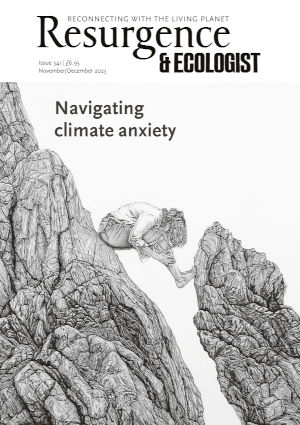Science should be taught like one of the human-ities – not simply as an apprenticeship for would-be researchers, but also as an aesthetic and spiritual pursuit for everyone: to show us all how wondrous the world really is and how privileged we are to be alive in it. This requires teachers who combine special expertise with broad vision – like the Italian botanist Stefano Mancuso.
Thus, in the fourth of his eight Tree Stories, Mancuso asks why the violins, violas and cellos that were made in and around the Lombardy town of Cremona in the 17th and 18th centuries by Antonio Stradivari, Nicolò Amati, Giuseppe Guarneri and others are so brilliant – and why no one since, despite endless efforts and expenditure, has been able to make anything that sounds as sweet. The answer lies in the microarchitecture of the spruce wood (Picea abies) used to make the soundbox: the precise dimensions and distribution of the resin-lined tubes of which coniferous timber is composed. But only those particular trees with a diameter of two feet or more have the right density – and trees of such a size must be at least 150 years old, and they must have grown slowly and at an even pace. Such conditions have been met only in special places at special times – notably through the Little Ice Age of Europe from the 15th to the 19th centuries. So suitable trees are rare – and when a master luthier found one, they hung on to it.
Analysis has shown that between 1695 and 1705 Stradivari made at least 14 violas and violins from the same tree. So of course such instruments can’t be emulated. Indeed, we will never see their like again. This story brings to mind the ‘Goldilocks principle’, which tells us that life, and especially conscious life, could not have evolved on Earth except through circumstances that seem so unlikely as to be well-nigh impossible. Yet life – even conscious life – exists. Hence the anthropic principle, one version of which maintains that the whole universe must have been set up expressly to produce humankind. But the same might be said of the greatest stringed instruments. It has taken the whole universe to produce them. Of course, they are one-offs.
Now, take cities. In effect, says Mancuso, the earliest cities were conceived as fortresses, with walls to separate those inside from the hostile world of predators and invaders outside. Inevitably, space within the walls was limited. There was no room to grow food, which meant the citizens relied absolutely on the surrounding farms. Indeed, the ideal city of the Italian Renaissance as conceived by artists like Leon Battista Alberti (1404–72) contained virtually no vegetation at all.
Towns and cities are no longer bound by walls, but the underlying mindset – people inside, plants outside – has persisted. A few privileged areas of a few rich cities are quite sylvan, as with London’s Royal Parks, but most are seriously deprived. Cities bring tremendous advantages (wealth, health care, transport, and so on) but there are huge downsides too, including, all too obviously, pollution. The problems become worse as populations grow and become more urbanised, as has been happening apace in recent decades. So it was that in 1950, when there were 2.5 billion people in the world, only 30% of them lived in cities – 750 million in all. Now there are 8 billon of us, and 60% (4.8 billion) of us live in cities: more than the total world population of 1980. Putting it another way, the population of people in cities has increased more than six times within the lifetimes of today’s pensioners.
In London the air was already pretty terrible in the 17th century, and in 1661 the diarist and gardener John Evelyn (1620–1706) suggested in his seminal book Fumifugium, or The Inconvenience of the Aer and Smoak of London Dissipated that trees should be planted in cities to clean the air, and that coal should be banned. Today the outstanding problem is not smoke, or even smoak, but global warming. Cities gobble up and dissipate energy, and their hard surfaces soak up the rays of the sun, so they tend to be far warmer than the countryside.
If the Earth heats up by two degrees by 2050 (which it seems almost bound to do), then big cities could heat up by more than six degrees. London could be like present-day Barcelona, and Oslo like Vienna. This might sound very acceptable, but worldwide many millions more people will die from heatstroke in the (frequent) heatwaves.
A study at Zurich Polytechnic in 2019 found that the best way to counter global warming is to plant a trillion more trees, both to soak up excess CO2 and to provide shade. Contra the Renaissance planners, cities should be positively sylvan. Indeed, says Mancuso, “Every surface should be covered with plants.”
Perhaps most cogent of all, however, is Mancuso’s third story: how it is that tree stumps, with no green branches and hence no energy from photosynthesis, may stay alive for decades, their sap rising and retreating in due season. The answer, he says, is that in a forest the roots of different trees – even of different species – may graft together (anastomosis), and are connected also by a forest-wide network of fungal hyphae known as mycorrhizae. Thus the forest is one giant, intimate cooperative.
Darwin, nice man though he was, emphasised Nature’s competitiveness – which has set the tone of modern biology and indeed of politics ever since. But, says Mancuso, biologists have focused on animals. If only they had known the ins and outs of forest trees, the course of world history might have run very differently.
Tree Stories: How Trees Plant Our World and Connect Our Lives by Stefano Mancuso (translated by Gregory Conti). Profile Books, 2023. ISBN: 9781800815469.







